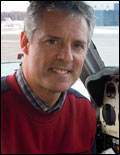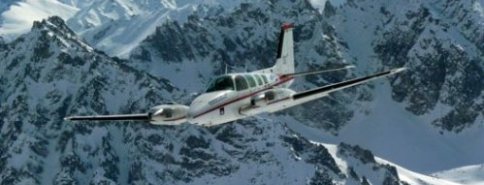The Pilots of Diabetes Formation Flight USA 2015
Douglas Cairns
 In 1989, Douglas Cairns was a British Royal Air Force jet pilot at the age of 25 when he was
diagnosed with type 1 diabetes, and consequently lost his flying career. In 2000 he regained
the freedom to fly in the USA as a licenced private pilot, and then went on to complete
"Diabetes World Flight" in 2003,
the first round-the-world flight by a pilot with type 1 diabetes.
In 1989, Douglas Cairns was a British Royal Air Force jet pilot at the age of 25 when he was
diagnosed with type 1 diabetes, and consequently lost his flying career. In 2000 he regained
the freedom to fly in the USA as a licenced private pilot, and then went on to complete
"Diabetes World Flight" in 2003,
the first round-the-world flight by a pilot with type 1 diabetes.
After completing his world flight Douglas wrote a book on his experiences (Dare to Dream:
Flying Solo With Diabetes) and spent three years in the USA giving sponsored motivational talks
to the diabetes community. During this time he set five world speed records and two transcontinental
speed records in the USA using the Diabetes World Flight "Beech Baron," and broke the
existing record to land in all 48 contiguous states of the USA
(www.diabetesflight48.com) before smashing the old
record to land in all 50 USA states in 5 days and 15 hours in 2010. In April 2011 he set a world
speed record between Barrow, Alaska and the North Pole, followed by the first ever landing in a
light twin-engine aircraft on the polar ice
(www.diabetespolarflight.org). Douglas is a
founder member of Pilots With Diabetes and is
passionate about raising awareness of diabetes, and gives regular talks to conferences &
meetings, highlighting that diabetes need not limit the scope of people's dreams and ambitions.
Douglas is based in London as an Asia Product Specialist with Veritas Asset Management.

Taylor Verett
 Taylor grew up dreaming of a career in military aviation and took his first step towards flying for the military
when he was accepted into the class of 2010 at the United States Air Force Academy. While attending the Air Force
Academy he majored in Computer Science - Cyber Warfare and was fortunate enough to participate in many of the
extracurricular aviation programs at his disposal including flying and instructing in gliders, flying the
Diamond DA-40 and even free-fall parachuting. Upon graduation Taylor received his commission in the U.S. Air
Force and attended Undergraduate Pilot Training (UPT) at Laughlin Air Force Base in Del Rio, TX. While at pilot
training Taylor flew the T-6 Texan II and went on to fly the T-1A, the military version of the BeechJet 400A.
Taylor grew up dreaming of a career in military aviation and took his first step towards flying for the military
when he was accepted into the class of 2010 at the United States Air Force Academy. While attending the Air Force
Academy he majored in Computer Science - Cyber Warfare and was fortunate enough to participate in many of the
extracurricular aviation programs at his disposal including flying and instructing in gliders, flying the
Diamond DA-40 and even free-fall parachuting. Upon graduation Taylor received his commission in the U.S. Air
Force and attended Undergraduate Pilot Training (UPT) at Laughlin Air Force Base in Del Rio, TX. While at pilot
training Taylor flew the T-6 Texan II and went on to fly the T-1A, the military version of the BeechJet 400A.
After graduation from pilot training Taylor was excited to be selected to fly his dream aircraft, the KC-10
“Extender”. Shortly after arriving for KC-10 initial training however, Taylor’s dream was cut short when he was
diagnosed with Type 1 Diabetes in the Fall of 2012. Although Taylor desired to continue his military service, his
Air Force career came to an end in August of 2013.
Taylor holds a Commercial Pilot’s License with single, multi-engine and instrument certifications and currently
lives in Olathe, KS with his wife Mary, where he works as an avionics software engineer. When he’s not flying or
working Taylor enjoys woodworking and playing golf.
Brian Strack
 Brian began his lifelong love of aviation at the age of 8 with his first airplane ride, and was hooked. He
attended the University of North Dakota, majoring in Aviation and Space Studies while earning a commission as
an officer in the U.S. Air Force through UND's ROTC program. He attended joint pilot training in Pensacola, FL
and Vance AFB, OK, where he remained as an Instructor Pilot in the T-1A Jayhawk, the military's version of the
BeechJet 400A. Brian was selected to fly the U-2 "Dragon Lady" at Beale AFB, CA, but shortly thereafter, that
dream ended when he was diagnosed with Type 1 diabetes.
Brian began his lifelong love of aviation at the age of 8 with his first airplane ride, and was hooked. He
attended the University of North Dakota, majoring in Aviation and Space Studies while earning a commission as
an officer in the U.S. Air Force through UND's ROTC program. He attended joint pilot training in Pensacola, FL
and Vance AFB, OK, where he remained as an Instructor Pilot in the T-1A Jayhawk, the military's version of the
BeechJet 400A. Brian was selected to fly the U-2 "Dragon Lady" at Beale AFB, CA, but shortly thereafter, that
dream ended when he was diagnosed with Type 1 diabetes.
Through the FAA's special issuance program, Brian has been able to maintain a Third Class medical and enjoy
flying civil aircraft as often as possible. He holds CFII and MEI Instructor certificates, and recently bought
his first airplane, an experimental Rutan VariEZE that he is currently updating with new modern instruments.
Brian lives in Edmond, OK with his wife Katie and still serves in the US Air Force. He is stationed as a Liaison
with the FAA in Oklahoma City, and continues to work with the Air Force Flight Standards Agency, and teach at the
USAF Advanced Instrument School. He is an avid outdoor enthusiast, getting away to hike, camp, road or mountain
bike, ski or snowshoe whenever the possibility arises.
Chris Isler
 Chris's love for aviation came early on. The son of a United States Navy aircraft carrier pilot turned commercial
pilot for Western Airlines, he was always in and around the airport and aircraft. He began flying around the
age of 13 in his family's Cessna 152 based in Torrance, California, and had always thought one summer he'd get his private
pilot license. It turns out during those years the beach was more of a draw.
Chris's love for aviation came early on. The son of a United States Navy aircraft carrier pilot turned commercial
pilot for Western Airlines, he was always in and around the airport and aircraft. He began flying around the
age of 13 in his family's Cessna 152 based in Torrance, California, and had always thought one summer he'd get his private
pilot license. It turns out during those years the beach was more of a draw.
Twenty-five years later at the age 40, Chris had been living with type one diabetes first diagnosed at age 28. He had been driving
past the airport where a large hanger had been flying a banner that read "Learn to Fly!!" for several years. On every
passing he'd say to himself "one day". One day and some 35 years after his first dream of flight he spun a
U turn and pulled into that flight school. He asked a few questions and an instructor that was standing by gave
him an overview and the requirements. He remembers being very excited and handed the woman at the counter his credit
card and asked her to charge the entire package at once so he'd never have an excuse. At that moment the
Instructor spoke out and said, "There was one more thing. You'll need an aviation medical, but you look fit.
You don't have heart disease or DIABETES, do you?" His heart sank.
Chris figured something would work out.
Chris's flight training began immediately and he flew through it right up until it was time to have his first solo.
His instructor told him he was ready and asked if he had gotten medical, a requirement for solo flight. He hadn't
until that point spoken much about having diabetes. So with a bit of concern, off he went to research how to
obtain what he learned was called a "special issuance medical". For anyone who doesn't know, it's a bit of work,
but very doable, if your diabetes is well controlled. It took about 4 months to get
everything required done, put together, and sent to the FAA. The longest part was waiting for review and approval
by the FAA. After all the work Chris was back on track and weeks away from his practical test, having completed
all he could and then some prior to his solo requirements.
Today three years and over 200 hours later, Chris is seeking an Instrument rating and loving owning his 172SP.